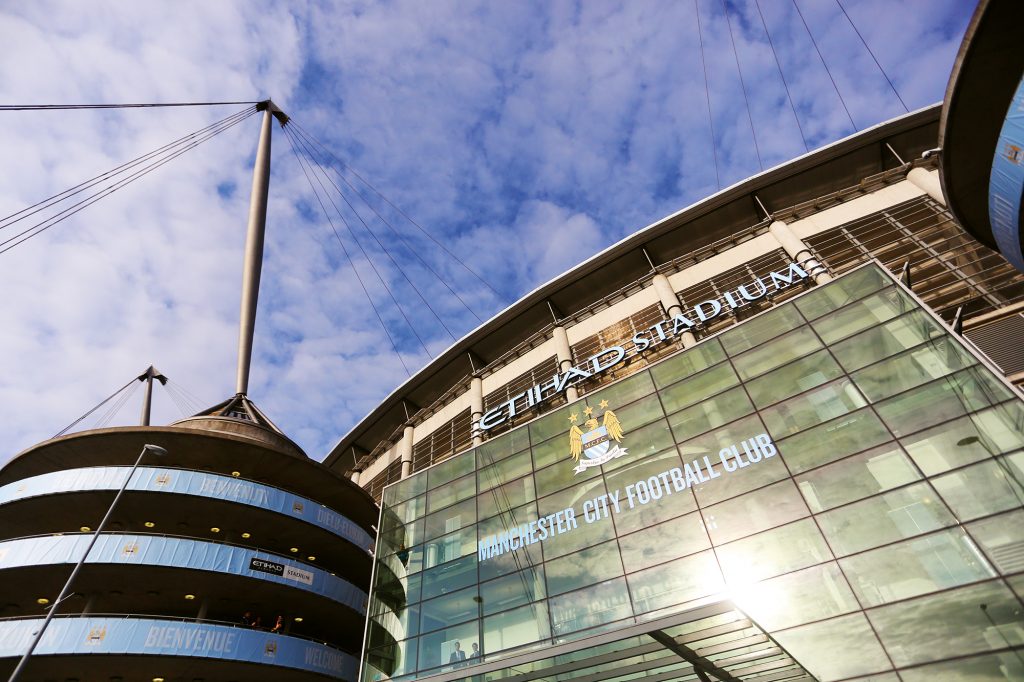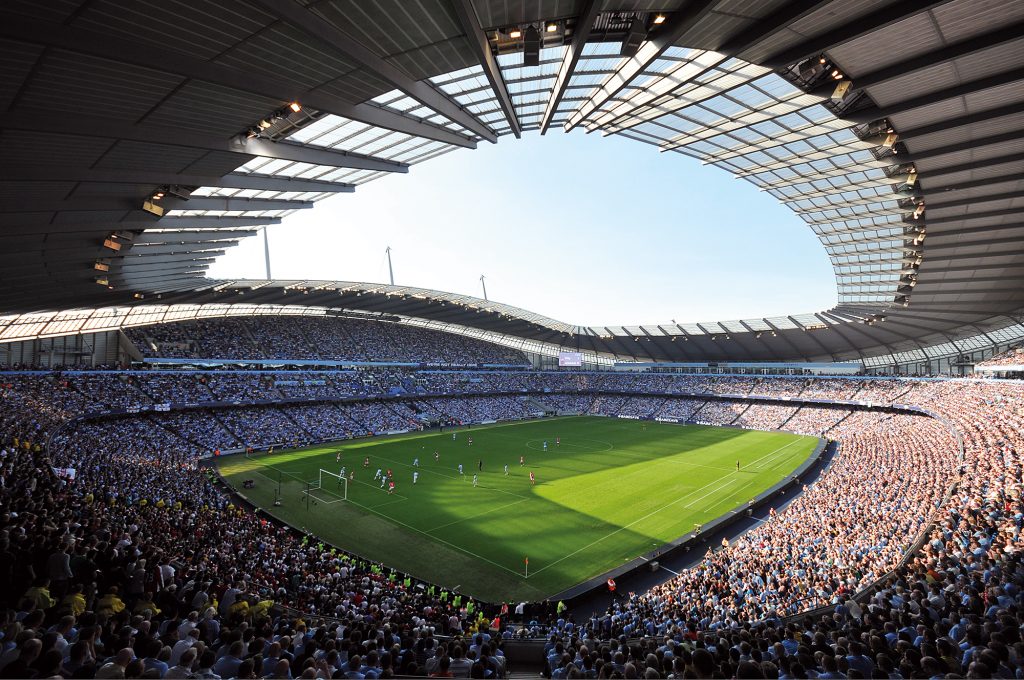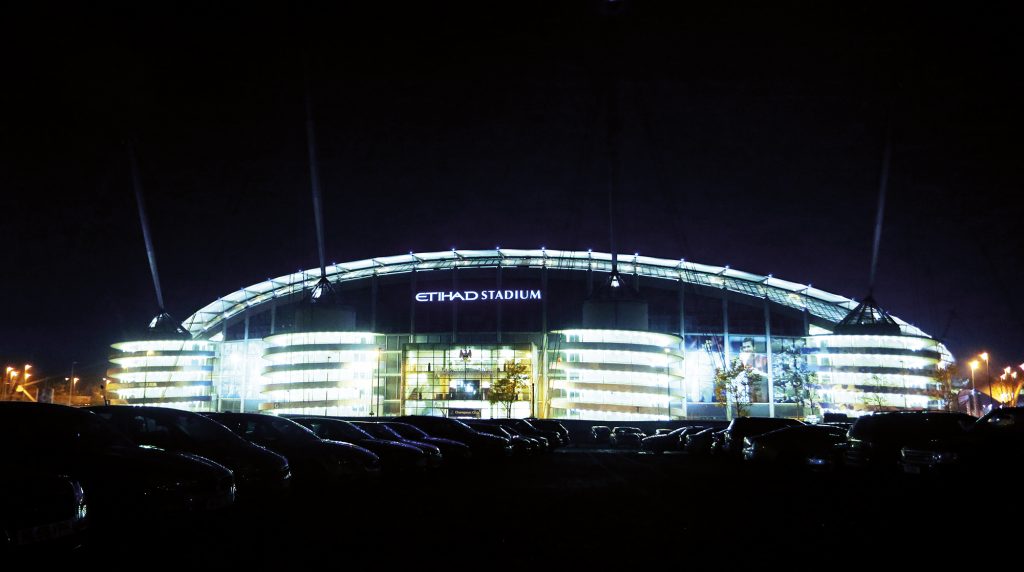Travel Guide for Manchester City and Etihad Stadium
Below you will find your perfect guide for going to England to watch Manchester City at the Etihad Stadium!
Headlines from the travel guide:

MANCHESTER CITY HONOURS
First Division/ Premier League: 5 (last 2018)
FA Cup: 5 (last 2011)
League Cup: 5 (last 2018)
Cup Winners’ Cup: 1 (1970)
ETIHAD STADIUM
Pitch: 105 x 68 m
Opening match: 10 August 2003 (Manchester C – Barcelona 2-1)
Etihad Stadium
Manchester
M11 3FF
ETIHAD STADIUM HISTORY
The stadium was built for the Commonwealth Games in 2002, then named the City of Manchester stadium, and cost £110 million. It was then converted it into a football stadium so Manchester City could move in with a 250 year lease. The rebuilding cost £35 million and was paid for by Manchester City.
The first goal in the new stadium was scored by Nicolas Anelka on August 10, 2003 in a friendly match between City and Barcelona (2-1).
In 2008 the UEFA Cup final was played there. Zenit St Petersburg beat Rangers 2-0 in a match that was goalless until the 72nd minute. Andrey Arshavin was named man of the match.
Etihad Stadium is part of a larger sports complex, Sportcity, including a facility for athletics, a velodrome and a squash centre.

ETIHAD STADIUM DIRECTIONS
Tram:
Take the Metrolink from Piccadilly Station towards Ashton and get off at Etihad Campus stop.
Walk:
There is a safe, well lit and signposted walking route available from Manchester Piccadilly Station. Follow the ‘City Link’ signs. It will take approximately 25 minutes to walk to the Etihad Stadium from the city centre.
ETIHAD STADIUM BARS
There are not too many pubs around the stadium. Additionally, away supporters are advised to keep a low profile. With that in mind, here are a few tips:
Mary D’Bemish Bar, 13 Grey Mare Lane
The Townley Hotel, Albert Street
Bradford Inn, 112-114 Bradford Road.
You may be better off enjoying a drink in the city centre. The Printworks near Victoria Station has lots of bars and food outlets.
Admission:
£17.00 – adults
£23.00 – students and pensioners
£12.00 – children
Family ticket: £54.00 (4 people)
Booking: +44 (0)161 444 1894
ETIHAD STADIUM TOUR
Monday – Saturday: :9:00 – 17:00
Sunday: 10:00 – 16:00
Admission:
£17.00 – adults
£23.00 – students and pensioners
£12.00 – children
Family ticket: £54.00 (4 people)
Booking: +44 (0)161 444 1894
MANCHESTER CITY STORES OPENING TIMES
CityStore
Etihad Stadium
Monday – Saturday: 9:00 – 17:30
Sunday: 11:00 – 17:00
CityStore In The City
21 Market Street
Manchester
M1 1WR
Monday – Friday: 10:00 – 19:00
Saturday: 9:00 – 19:00
Sunday: 11:00 – 17:00

MANCHESTER CITY TRAINING GROUND
Manchester City moved into a new state of the art training complex close to the Etihad Stadium in 2014. It is based on AC Milan’s training complex and is one of the finest in the world.
The club invested £50 million in the new facilities. They have leased out their former Carrington training ground to Bury FC.
MANCHESTER CITY CLUB HISTORY
Manchester City’s roots date back to 1880 when pastor’s daughter Anna Connell, along with two churchwardens from St Mark’s Church, founded a football club: St Mark’s (West Gorton). After a merger with Gorton Athletic, the name was changed some years later to Gorton AFC. In 1887 the club moved to a new pitch at Hyde Road and it was time for another change of name – this time to Ardwick AFC. Under this name the club won the Manchester Cup twice. But financial difficulties in 1894 led to a reorganisation and forced yet another name change …
Manchester City Football Club Limited was officially founded on April 16, 1894, and after winning the Division 2 championship in 1899 the team moved up in the top tier. Five years later, City were the first team from Manchester to land a major title: the FA Cup was brought home after Bolton Wanderers were defeated 1-0 at Crystal Palace.
The following year City were prosecuted for financial irregularities when the chairman, manager, two directors and no fewer than 17 players were hit by suspensions and fines. To top it all, the majority of the suspended players moved to Manchester United.
1926 was an eventful year in City’s history: they were the first team from Manchester to play at Wembley (losing 1-0 to Bolton in the FA Cup Final). They also celebrated their biggest derby success at the time (United were crushed 6-1 at Old Trafford). But despite this joy the season ended in relegation.
Manchester City: big crowds
Two years later City were back in football’s high society and drew the biggest crowds in the entire league. The thirties brought both despair and success: they made two consecutive FA Cup finals, losing in 1933 but winning in 1934. The league championship was won in 1937 but relegation followed the next year – although City did score more goals than any other team in the division.
In the fifties, there were two further consecutive FA Cup Finals. The story of the 1930s was repeated: a loss in 1955 was followed by victory in 1956. They beat Birmingham City 3-1 and City’s goalkeeper Bert Trautmann completed the match with a broken neck …
With the former England captain Joe Mercer as manager and the young Malcolm Allison as his assistant 1965 saw the beginning of a brilliant era for the City.
Promotion to the top division came in 1966, with the league championship secured in 1968, FA Cup success followed in 1969 and victory in the Cup Winners Cup came in 1970. City also won the League Cup in 1970 and wrote themselves into English football history as the first team to win titles domestically and in Europe in the same year.
Manchester City relegate Manchester United
The last league match of the 1973/74 season is fondly remembered by many City supporters. The opponents were Manchester United, who had to win to avoid relegation. A goal by the former United player Denis Law saw City send their arch rivals down to the second division …
After having fallen out of the Premier League in 1996, two years later City suffered a further relegation and found themselves in the third level of the league for the first time ever. But revenge was swift.
After a penalty shoot out against Gillingham in the league play-off final City departed that division straight away, and the following year took the leap back to the Premier League.
With strong financial backing and Roberto Mancini as manager a new era began in City’s history. The first title in 35 years was captured in 2011 when Stoke City were defeated in the FA Cup final. Yaya Toure scored the only goal shortly before the final whistle.
City win Premier League title
The 2011/12 season then ended in the ultimate drama. Going into the final day of the season, the two Manchester teams were level on points. City, however, had an superior goal difference, thanks largely to winning 6-1 at Old Trafford for the second time in their history.
United won their away game against Sunderland, and after 90 minutes City were 2-1 down at home to QPR but two goals in injury time (Dzeko and Aguero) turned the match and secured the league title.
Another league title followed two years later and in addition City won the League Cup in both 2014 and 2016. But on the European stage things have moved a bit slower. A semi-final in the Champions League in 2016 (losing to Real Madrid after a single goal in two games) is the best performance so far.
Later that year Pep Guardiola arrived at the Etihad and hopes were high that he could deliver the success the fans, and owners, craved. It wasn’t quite an overnight success – the first season passed without silverware, a rarity for Guardiola.
However a dream team including Kevin De Bruyne, Leroy Sané and Sergio Agüero wouldn’t be denied another season. In 2017/18 they blew away all comers in the Premier League, racing to the title with a record number of points and goals. At one stage all four major trophies looked on for City – in the end they had to settle for the Premier League and League Cup.
Manchester City previous venues
1880-1881 St Mark’s (Gorton) – Clowes Street, Parish of St Mark’s Gorton West.
St Mark’s first match was played here in November 1880.
1881-1882 West Gorton (St Mark’s) – Kirkmanshulme Cricket Ground, Redgate Lane, Gorton.
When Clowes Street was condemned as a football field because of the pitch the club moved into a nearby ground that belonged to Kirkmanshulme Cricket Club. The surface was really nice but at the end of the football season the board of Kirkmanshulme Cricket Club saw that their ground was being destroyed and the football team was thrown out.
1882-1884 West Gorton – Clemington Park, Queens Road.
The club found a new pitch in this park that was barely a stone’s throw from their first pitch in Clowes Street. When the team played up to 1,000 spectators came to watch.
1884-1887 Gorton AFC – Pink Bank Lane, Gorton.
At the beginning of the season, the ground was discussed again. Lawrence Furniss Board proposed to shift to a pitch that was at Pink Bank Lane and although the ground was uneven and rocky they decided to sign a contract with the landowner. Volunteers worked hard to level off and clear the stone so that the pitch eventually became playable.
1887-1923 Ardwick AFC who became Manchester City 1894 -1923 Hyde Road, Bennett Street, Ardwick.
The team played their matches on a site in Reddish Lane for a short time. The club, however, was forced to move because of the high lease costs. Their new home became Hyde Road, the most famous arena before Maine Road. 1920 was a memorable year at Hyde Road. First King George V visited the venue but seven months later a fire destroyed the main grandstand.
Manchester City: Maine Road
1923 – 2003 Maine Road
Manchester City moved to Maine Road in 1923 and it is said that a curse rested over the arena. Before Maine Road was built this area was inhabited by gypsies who were forced to move when the stadium was built.
The new home enabled City to attract more people to come and watch the games. Even today it holds the club attendance record for an English league match: 84,569 spectators watched City play against Stoke in 1934.
Despite the bitter rivalry between the two big clubs in Manchester, they have actually played their home games at the same venue. During the Second World War Old Trafford was hit by bombs and United played their games at Maine Road while repair work took place.
MANCHESTER CITY FACTS
Billy Meredith played his last game for City in the FA Cup semi-final against Newcastle United in 1924. He was then 49 years old.
The FA Cup Final in 1933 was the first to see numbers used on jerseys. Everton’s players had numbers 1 – 11 and the City’s players had to make do with the numbers 12-22 with goalkeeper Len Langford as number 22.
When City met Luton Town in the FA Cup in 1961 the 20-year-old Denis Law scored a hat-trick in the first half. Not only that – he scored three more goals during the first 20 minutes after the break. But shortly after his sixth goal came a downpour that forced the referee to stop the match. Luton Town won the replay 3-1 and Denis Law’s six goals were washed away …